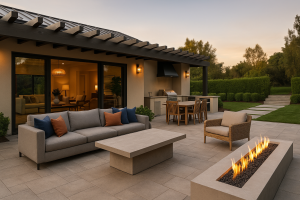Choosing the right roofing material is important for the overall durability and cost-effectiveness of a roof. Among the most popular options in the market today are fiberglass shingles and asphalt shingles. In this comparative guide, we dive into the details of both materials, exploring their composition, durability, cost, and maintenance requirements. By the end of this article, you will have a better understanding of which material is suitable for your particular roofing needs. Let’s get started!
What are Fiberglass Shingles?
Fiberglass shingles are a type of asphalt shingle that is reinforced with fiberglass. This roofing material is composed of a mat of woven fiberglass that is coated with asphalt to create a waterproof barrier. The mat is then covered with ceramic granules that protect the shingles from sun damage and add color and texture to the roof.
Fiberglass shingles are manufactured by layering the mat and asphalt in a continuous process, resulting in a light, flexible, and durable roofing material. These shingles are typically available in a wide range of colors, shapes, and sizes, allowing homeowners to choose a style that suits their preferences and architectural design.
What are the Benefits of Fiberglass Shingles?
| Advantages | Disadvantages |
|---|---|
| Fiberglass shingles are lightweight and easy to install, reducing labor costs and time. | Fiberglass shingles are generally more expensive than standard asphalt shingles. |
| Fiberglass shingles are fire-resistant and have a Class A fire rating. | Fiberglass shingles are not recommended for roofs with low slopes or high levels of moisture. |
| Fiberglass shingles are resistant to weather elements, such as wind, rain, and hail. | Fiberglass shingles are not as impact-resistant as other roofing materials, such as metal or slate. |
| Fiberglass shingles offer a long lifespan of up to 50 years with proper maintenance. | Fiberglass shingles are not as energy-efficient as other roofing materials, such as metal or clay tiles. |
Overall, fiberglass shingles are known for their durability, versatility, and aesthetic appeal. They are a popular choice among homeowners who want a high-quality roofing material that can withstand harsh weather conditions and last for decades.
What are Asphalt Shingles?
Asphalt shingles are a popular roofing material made from a base material, fiberglass mat, and top layer of asphalt granules. They are widely used in residential and commercial roofing due to their affordability, durability, and ease of installation.
The base material of asphalt shingles is typically organic felt or fiberglass mat, which provides strength and stability. The mat is then coated with asphalt and topped with ceramic granules that protect the asphalt from UV radiation and add color to the shingles.
Asphalt shingles come in a variety of styles and colors, making them a versatile option for any type of building. Some of the popular styles include three-tab shingles, architectural shingles, and designer shingles. They can mimic the look of other roofing materials such as wood or slate without the cost and maintenance requirements.
One of the main advantages of asphalt shingles is their affordability. They are one of the most cost-effective roofing materials on the market, making them a popular choice for homeowners and builders alike. Additionally, they are easy to install, which can further lower the overall cost of a roofing project.
However, asphalt shingles are not without their drawbacks. They have a shorter lifespan compared to some other roofing materials, typically lasting between 20 to 30 years depending on the quality of the shingle and the climate. They are also more susceptible to damage from severe weather conditions like hail or high winds, which can result in costly repairs or replacements. Additionally, the production and disposal of asphalt shingles can have negative environmental impacts.
Durability of Fiberglass Shingles
Fiberglass shingles are known for their exceptional durability and ability to withstand harsh weather conditions. They are made of a strong fiberglass mat, which is coated with asphalt and topped with ceramic granules. This combination creates a highly resilient roofing material that can last for many years.
One of the main advantages of fiberglass shingles is their resistance to impact. They are less likely to crack or shatter when struck by hail or other debris compared to their asphalt counterparts. Additionally, fiberglass shingles are non-porous, making them highly resistant to water damage and algae growth.
| Weather condition | Durability of Fiberglass Shingles |
|---|---|
| Extreme heat and sun exposure | Fiberglass shingles have a high resistance to UV radiation and do not degrade easily under intense sunlight. |
| Freezing temperatures and ice dams | Fiberglass shingles remain flexible in low temperatures, reducing the risk of cracking or breakage. They also prevent ice dams from forming due to their smooth surface. |
| Heavy rain and winds | Fiberglass shingles have a high wind resistance and can withstand gusts of up to 130 mph. |
| Hail and debris impact | Fiberglass shingles are impact-resistant and less likely to crack or tear due to hail or debris. |
Compared to asphalt shingles, fiberglass shingles have a longer lifespan and require less maintenance. They are also more fire-resistant, making them a safer choice for homes in wildfire-prone areas.
Overall, fiberglass shingles are a highly durable and long-lasting roofing material that can provide excellent protection for your home.
Durability of Asphalt Shingles
Asphalt shingles are known for their durability and long lifespan. They can last up to 20-30 years depending on the quality of the shingles and the maintenance provided by the homeowner. The durability of asphalt shingles comes from their ability to withstand various weather conditions and resist damage over time.
One of the key factors that contribute to the durability of asphalt shingles is their resistance to UV radiation. Asphalt shingles are made with a protective layer of mineral granules that helps to reflect the sun’s rays, preventing the shingles from cracking or deteriorating over time. This helps to keep your home well-protected from the elements year-round.
Asphalt shingles are also able to withstand strong winds and heavy rain without significant damage, making them a popular choice for homeowners in areas with severe weather conditions. Additionally, the fire-resistant nature of many asphalt shingles makes them a safe choice for homes in areas prone to wildfires.
Environmental Impact
While asphalt shingles are known for their durability, they do have some potential drawbacks in terms of their environmental impact. The manufacturing process for asphalt shingles can be energy-intensive and produce significant amounts of waste.
Additionally, when asphalt shingles reach the end of their lifespan, they typically end up in landfills, where they can take decades or even centuries to decompose. This can have a negative impact on the environment and contribute to issues like soil and groundwater contamination.
Overall, while asphalt shingles are a durable and popular roofing option, it’s important to consider their potential environmental impact and explore alternative options if sustainability is a priority for you.
Pros and Cons of Fiberglass Shingles
Fiberglass shingles are a popular roofing option that offers a distinct set of advantages and disadvantages. It is important to consider these factors carefully before making a decision:
| Pros | Cons |
|---|---|
| Fiberglass shingles are lightweight, making them easy to install and transport. | They are not as impact-resistant as other roofing materials, which can lead to damage in severe weather conditions. |
| They are highly fire-resistant, making them a safer option for homes and buildings. | Fiberglass shingles tend to be more expensive than asphalt shingles, which can impact the overall cost of a roofing project. |
| Fiberglass shingles have a longer lifespan than asphalt shingles, which can make them a more cost-effective option in the long run. | They do not have the same range of color and style options as asphalt shingles, which can limit design possibilities. |
| They are highly resistant to weather elements like UV radiation, moisture, and temperature fluctuations. | Installation of fiberglass shingles requires more skill and attention to detail than asphalt shingles, which can increase labor costs. |
Overall, fiberglass shingles offer a strong combination of durability, safety, and longevity, but may come at a higher cost. The decision to use fiberglass shingles should be based on a variety of factors specific to your roofing needs and budget.
Pros and Cons of Asphalt Shingles
Asphalt shingles are a popular roofing material for several reasons, but as with any roofing product, there are pros and cons to consider before making a final decision.
Pros
| Advantages | Description |
|---|---|
| Affordability | Asphalt shingles are a cost-effective roofing option for homeowners on a budget, as they are generally less expensive than other roofing materials. |
| Versatility | Asphalt shingles come in a wide range of colors and styles, making it easy to find a product that fits the aesthetic of any home. |
| Easy installation | Asphalt shingles are relatively simple to install, which makes them a popular choice for DIY homeowners. |
| Availability | Asphalt shingles are widely available and can be purchased at most home improvement stores, making them an easily accessible product. |
Cons
| Disadvantages | Description |
|---|---|
| Susceptibility to damage | Asphalt shingles can be easily damaged by strong winds and heavy rain, which can lead to expensive repairs or replacement. |
| Environmental impact | The production of asphalt shingles can have a significant environmental impact due to the use of non-renewable resources and the creation of waste during the manufacturing process. |
| Shorter lifespan | Unlike some other roofing materials, asphalt shingles have a relatively short lifespan and may need to be replaced every 15-30 years. |
Cost Comparison: Fiberglass Shingles vs. Asphalt Shingles
One of the biggest factors that homeowners consider when choosing between fiberglass shingles and asphalt shingles is cost. While both options can be affordable, the overall cost can vary depending on several factors.
| Fiberglass Shingles | Asphalt Shingles | |
|---|---|---|
| Material Cost | Fiberglass shingles are generally more expensive than asphalt shingles, with an average cost of $3.50 to $5.50 per square foot. | Asphalt shingles are typically less expensive than fiberglass shingles, with an average cost of $1.50 to $3.50 per square foot. |
| Installation Expenses | The installation process for fiberglass shingles is typically more complicated and labor-intensive, which can add to the overall cost. However, because they are lightweight, they can often be installed more quickly and with fewer laborers, which can help offset the higher material cost. | The installation process for asphalt shingles is generally simpler and less labor-intensive, which can make it a more affordable option overall. |
| Long-term Maintenance Costs | Fiberglass shingles require less maintenance than asphalt shingles, which can help offset the higher initial cost. They have a longer lifespan and are more durable, so homeowners may not need to replace them as often. Additionally, fiberglass shingles are resistant to mold and algae, which can save homeowners money on cleaning and maintenance costs over time. | Asphalt shingles are more susceptible to damage from weather and UV radiation, which can lead to more frequent repairs and replacements. Additionally, they are more prone to developing mold and algae, which can increase cleaning and maintenance costs. |
Ultimately, the cost-effectiveness of fiberglass shingles versus asphalt shingles will depend on several factors, including the size and complexity of the roof, the desired aesthetics, and the long-term goals of the homeowner. It’s important to consider all of these factors carefully when making a decision.
Choosing the Right Roofing Material for Your Needs
When it comes to selecting a roofing material, there are several factors to consider. Here are some tips to help you choose between fiberglass shingles and asphalt shingles:
- Climate: Consider the climate in your area. If you live in an area with frequent extreme weather, fiberglass shingles may be a better option due to their durability and resistance to weather elements.
- Budget: Determine your budget for the roofing project. Asphalt shingles are generally more affordable than fiberglass shingles.
- Aesthetics: Decide on the desired look for your home. Asphalt shingles offer a wide range of style options, while fiberglass shingles come in limited colors and designs.
- Long-term goals: Consider your long-term goals and plans for the property. Fiberglass shingles may be a better investment due to their longer lifespan, while asphalt shingles may be a better option for those planning to sell or upgrade in the near future.
By carefully considering these factors, you can make an informed decision on which roofing material best suits your needs.
Maintenance and Repairs: Fiberglass Shingles vs. Asphalt Shingles
Maintaining and repairing your roof is an essential part of ensuring its longevity and protecting your home from the elements. Both fiberglass shingles and asphalt shingles have their own maintenance requirements and potential repair issues to consider.
Maintenance Requirements
Fiberglass shingles are relatively low maintenance and do not require any special treatment to maintain their durability. They can be cleaned with a mild detergent and water to remove any debris or dirt buildup. It is important to avoid using a power washer, as the high pressure can damage the shingles.
Asphalt shingles also require minimal maintenance, including occasional cleaning to remove any debris or moss buildup. However, they can be susceptible to cracking or splitting in extreme weather conditions, which may require repair.
Repair Issues
If fiberglass shingles are damaged, they can be difficult to repair due to their composition. In most cases, damaged shingles will need to be replaced entirely rather than repaired.
Asphalt shingles, on the other hand, are easier to repair. Cracked or split shingles can be replaced individually, which can be a cost-effective solution if the damage is localized.
Cost and Frequency of Repairs
The cost and frequency of repairs for fiberglass shingles and asphalt shingles can vary depending on several factors, including the extent of the damage and the accessibility of the affected area.
Repairing fiberglass shingles can be more expensive than repairing asphalt shingles, as damaged shingles will likely need to be replaced entirely. However, because fiberglass shingles are more durable and less susceptible to damage than asphalt shingles, they may require fewer repairs over the roof’s lifespan.
Asphalt shingles may require more repairs over time, particularly if they are exposed to extreme weather conditions or are not installed properly. However, because they are easier to repair than fiberglass shingles, these repairs may be more affordable in the short term.
Frequently Asked Questions (FAQ) about Fiberglass Shingles and Asphalt Shingles
If you are considering roofing your home with either fiberglass shingles or asphalt shingles, you likely have some questions. Here are some frequently asked questions about these two popular roofing options:
Are fiberglass shingles better than asphalt shingles?
It depends on your needs and preferences. Fiberglass shingles are known for their durability, resistance to harsh weather, and lightweight nature. Asphalt shingles, on the other hand, are affordable, come in a wide range of styles, and are easy to install. Consider factors such as climate, budget, and the overall look you are trying to achieve when deciding which option is best for you.
What is the lifespan of fiberglass shingles versus asphalt shingles?
Fiberglass shingles typically last longer than asphalt shingles. While asphalt shingles may have a lifespan of 20 to 30 years, fiberglass shingles can last up to 50 years. Of course, this lifespan can vary depending on factors such as the quality of the material, the installation process, and the weather conditions in your area.
Are fiberglass shingles more expensive than asphalt shingles?
Fiberglass shingles are generally more expensive than asphalt shingles. However, they offer greater durability and longevity, which can make them a worthwhile investment in the long run. Additionally, the price difference between the two options may be less significant when you consider the cost of maintenance and repairs over time.
Can fiberglass shingles be recycled?
Yes, fiberglass shingles can be recycled. This makes them a more environmentally friendly option than asphalt shingles, which are typically not recyclable and end up in landfills. However, it is important to note that not all recycling facilities accept fiberglass shingles, so you should check with your local recycling center before disposing of them.
Are fiberglass shingles energy-efficient?
Yes, fiberglass shingles can be energy-efficient. Some manufacturers offer options that are designed to reflect sunlight and reduce heat absorption, which can help lower energy costs. However, it is important to note that not all fiberglass shingles are created equal, so you should research the specific options available to determine if they are energy-efficient.
Do fiberglass shingles require a special installation process?
No, fiberglass shingles do not require a special installation process. They can be installed using standard roofing techniques. However, it is important to hire an experienced roofing professional for the installation process to ensure that it is done correctly and to avoid potential issues down the line.








